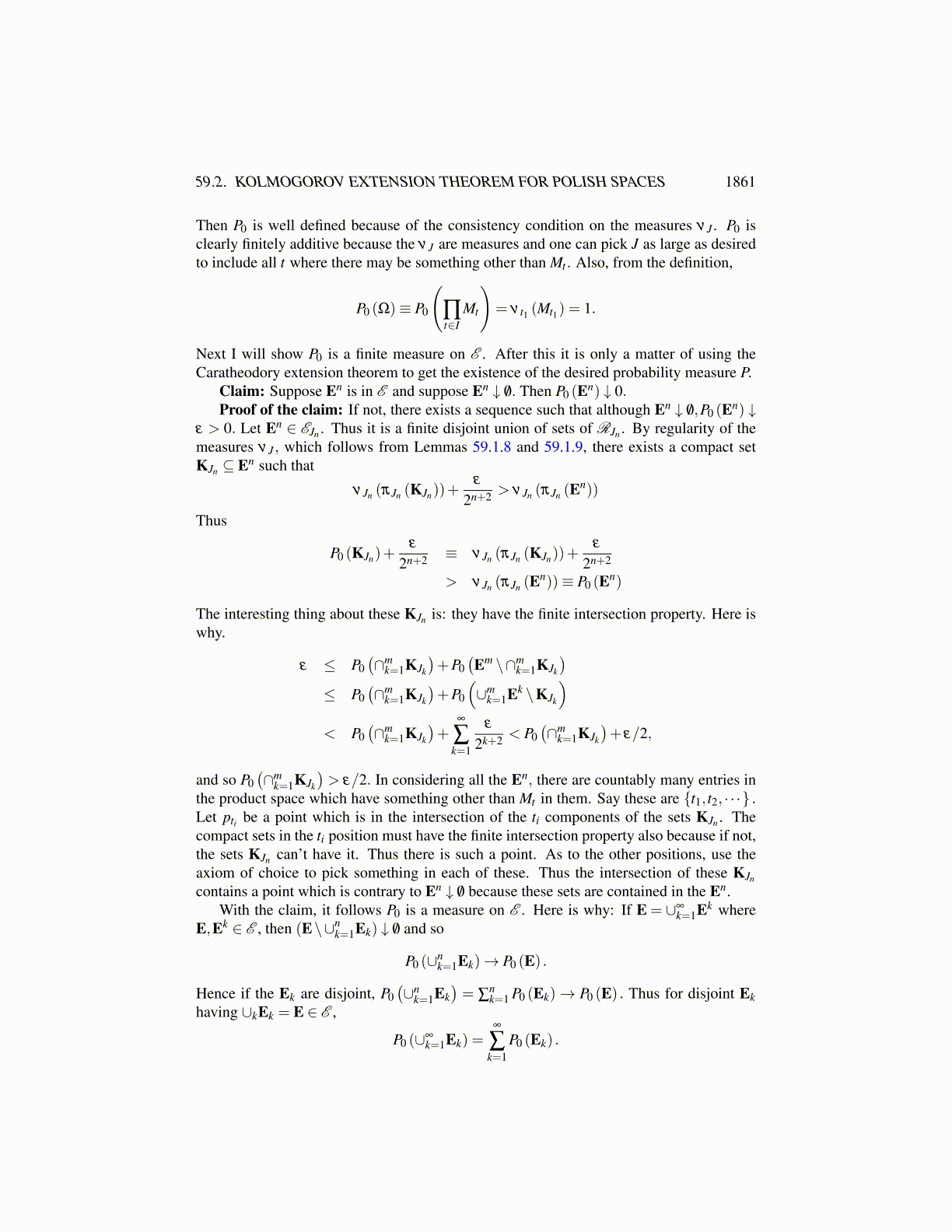
59.2. KOLMOGOROV EXTENSION THEOREM FOR POLISH SPACES 1861
Thus the identity map on E is in L1 (E;λ X) . Next suppose the identity map h is in ab-solutely integrable, in L1 (E;λ X) . Then X(ω) = h ◦X(ω) and so from the first part,X ∈ L1 (Ω;E) and from 59.1.1, 59.1.2 follows.
59.2 Kolmogorov Extension Theorem For Polish SpacesLet Mt be a complete separable metric space. This is called a Polish space. I will denotea totally ordered index set, (Like R) and the interest will be in building a measure on theproduct space, ∏t∈I Mt . By the well ordering principle, you can always put an order on anyindex set so this order is no restriction, but we do not insist on a well order and in fact, indexsets of great interest are R or [0,∞). Also for X a topological space, B (X) will denote theBorel sets.
Notation 59.2.1 The symbol J will denote a finite subset of I,J = (t1, · · · , tn) , the ti takenin order. EJ will denote a set which has a set Et of B (Mt) in the tth position for t ∈ J andfor t /∈ J, the set in the tth position will be Mt . KJ will denote a set which has a compact setin the tth position for t ∈ J and for t /∈ J, the set in the tth position will be Mt . Also denoteby RJ the sets EJ and R the union of the RJ . Let EJ denote finite disjoint unions of sets ofRJ and let E denote finite disjoint unions of sets of R. Thus if F is a set of E , there existsJ such that F is a finite disjoint union of sets of RJ . For F ∈ Ω, denote by πJ (F) the set∏t∈J Ft where F =∏t∈I Ft .
Lemma 59.2.2 The sets, E ,EJ defined above form an algebra of sets of ∏t∈I Mt .
Proof: First consider RJ . If A,B ∈RJ , then A∩B ∈RJ also. Is A\B a finite disjointunion of sets of RJ? It suffices to verify that πJ (A\B) is a finite disjoint union of πJ (RJ).Let |J| denote the number of indices in J. If |J| = 1, then it is obvious that πJ (A\B) is afinite disjoint union of sets of πJ (RJ). In fact, letting J = (t) and the tth entry of A is A andthe tth entry of B is B, then the tth entry of A\B is A\B, a Borel set of Mt , a finite disjointunion of Borel sets of Mt .
Suppose then that for A,B sets of RJ , πJ (A\B) is a finite disjoint union of sets ofπJ (RJ) for |J| ≤ n, and consider J = (t1, · · · , tn, tn+1) . Let the tth
i entry of A and B berespectively Ai and Bi. It follows that πJ (A\B) has the following in the entries for J
(A1×A2×·· ·×An×An+1)\ (B1×B2×·· ·×Bn×Bn+1)
Letting A represent A1×A2×·· ·×An and B represent B1×B2×·· ·×Bn, this is of the form
A× (An+1 \Bn+1)∪ (A\B)× (An+1∩Bn+1)
By induction, (A\B) is the finite disjoint union of sets of R(t1,··· ,tn). Therefore, the aboveis the finite disjoint union of sets of RJ . It follows that EJ is an algebra.
Now suppose A,B ∈ R. Then for some finite set J, both are in RJ . Then from whatwas just shown,
A\B ∈ EJ ⊆ E , A∩B ∈R.
By Lemma 12.10.2 on Page 318 this shows E is an algebra.